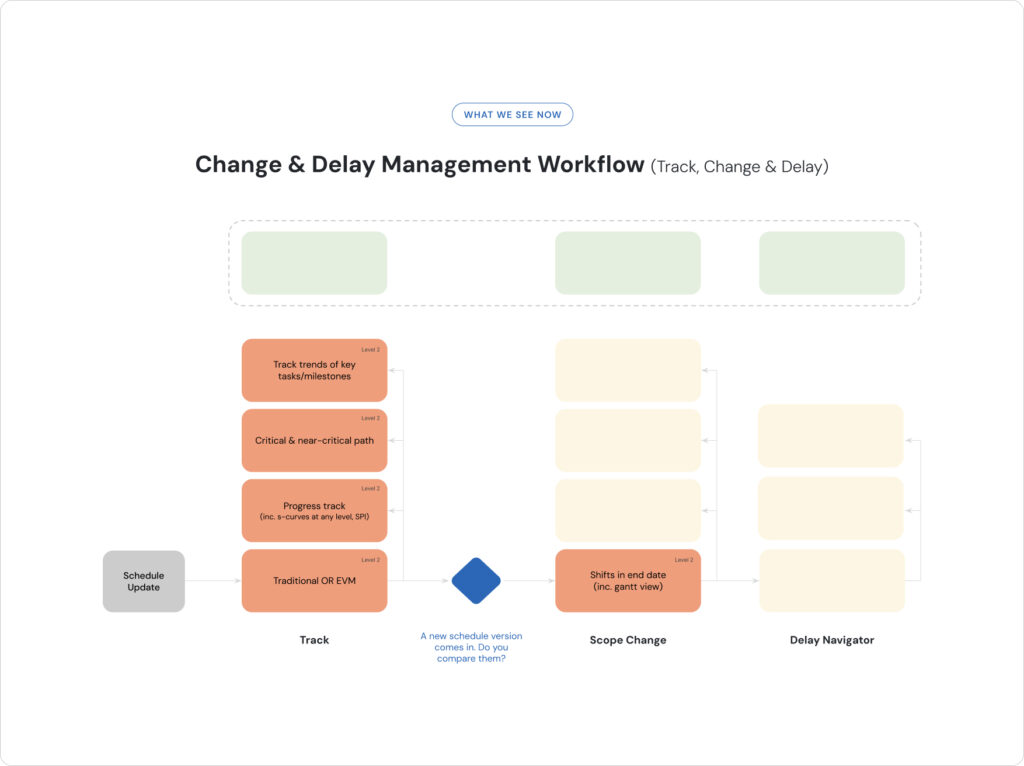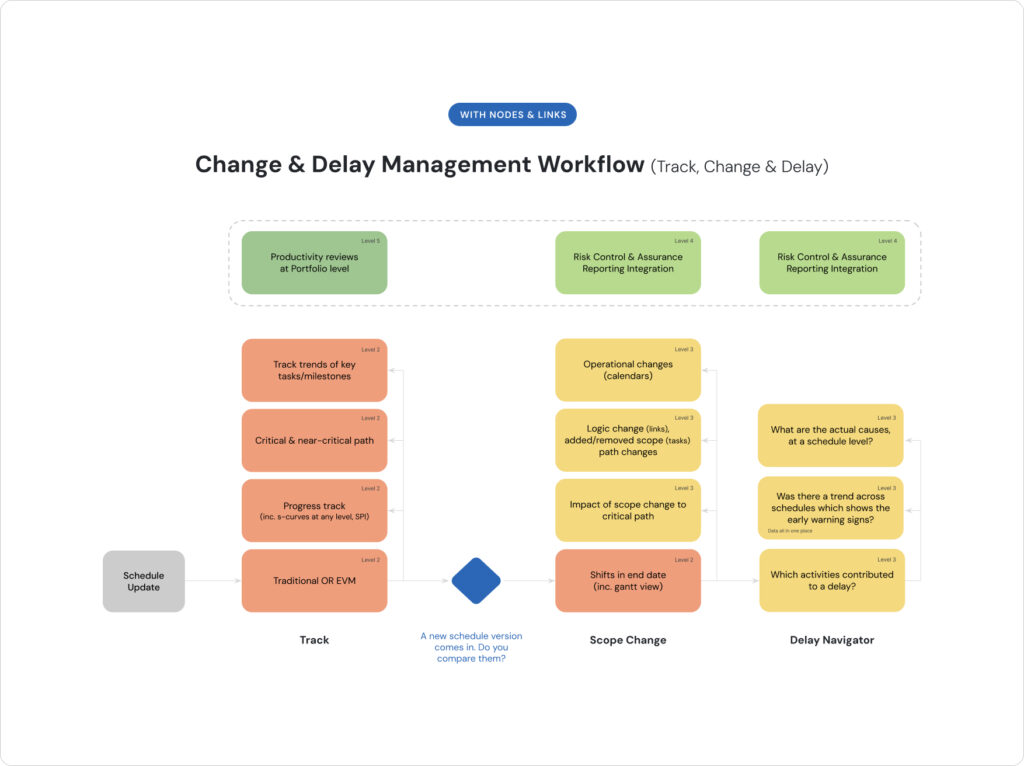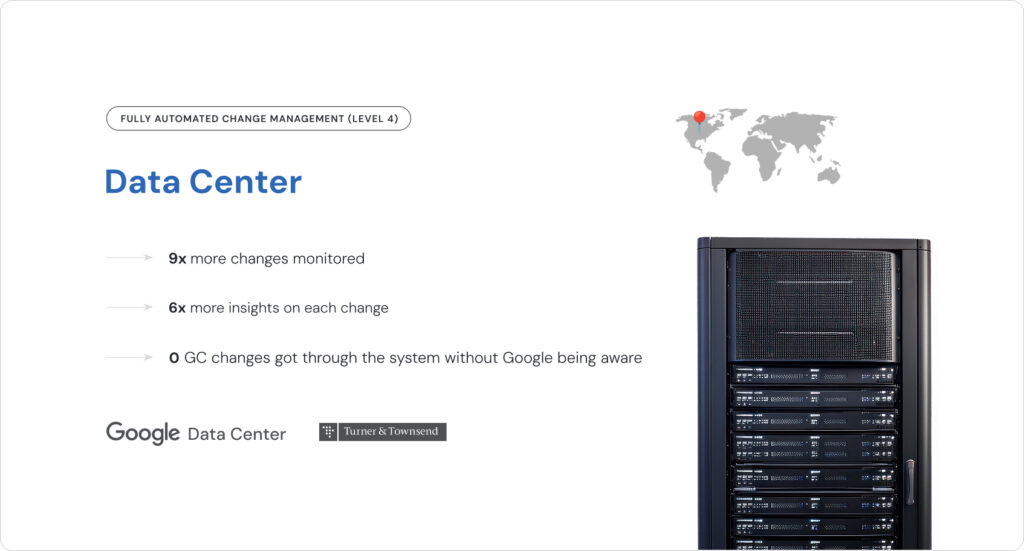Change is inevitable in every major project. The question is not if it will happen, but when, how often, and how quickly you’ll know about it.
Across the industry, project teams struggle to manage the ripple effects of change. Baseline slippage goes unnoticed. The critical path quietly shifts. Delays accumulate until they are too big to ignore.
In most cases, the issue isn’t the change itself. It’s the lack of visibility into it.
That’s where Change and Delay Management becomes the defining factor between predictable and unpredictable projects.
What Change and Delay Management Means in Scheduling
In scheduling terms, Change and Delay Management is the process of identifying, analyzing, and responding to changes in a schedule, whether they come from scope modifications, logic updates, or progress variances.
The goal is to understand how each change impacts the project’s overall timeline and cost exposure.
In practice, this means:
- Comparing each new schedule version against the previous one
- Tracking what changed, why it changed, and how it affects the critical path
- Using that insight to prevent small shifts from compounding into major delays
It is the heartbeat of schedule assurance. It is the feedback loop that ensures every update improves understanding rather than increasing uncertainty.
Why Change and Delay Management Matters
Without systematic change and delay management, projects are forced into forensic firefighting, reacting to problems long after they’ve already occurred.
The symptoms are familiar:
- Frequent disputes and claims. Teams disagree on what caused a delay.
- Missed early warnings. Version control gaps hide schedule drift until milestones slip.
- Reactive mitigation. Delays are analyzed only when executives request a report.
- Loss of trust. No one is confident the data reflects reality.
This lack of control creates a high-risk environment where every update introduces uncertainty rather than clarity.
Conversely, when change and delay management is embedded into the assurance process, organizations can detect issues before they escalate, measure their impact, and prevent rework before it happens.
What the Industry Is Doing Today

In most organizations, change and delay management still sits at Level 2: Forensic Firefighting.
Teams perform periodic comparisons between schedule versions, often manually, using P6 exports, spreadsheets, or static reports. The focus is on catching up, not keeping up.
Typical workflows include:
- Tracking task trends and milestones manually
- Reviewing progress via s-curves or SPI metrics
- Observing shifts in end dates or critical paths only after an update is submitted
These methods create snapshots rather than visibility. By the time teams realize a delay has occurred, it’s already too late to prevent it.
This reactive approach means change is always managed after the fact, and cumulative impacts often go unnoticed until they surface in cost overruns or disputes.
What Leading Organizations Are Doing Instead

High-performing organizations have replaced reactive workflows with automated, integrated change and delay systems that provide real-time insight across portfolios.
Here’s what this looks like in practice:
- Automated comparisons. Every schedule update is automatically compared with the previous version.
- Change categorization. Scope, logic, and operational changes are identified and classified.
- Impact mapping. Delays and scope changes are directly linked to the critical path.
- Trend analysis. Early warning signs are detected by monitoring change patterns across schedules.
- Integration. Results feed directly into risk and assurance reporting.
With these capabilities, teams can see not only what changed, but also why, when, and how it affects future delivery.
This shift moves change management from a post-mortem exercise into a predictive control function that continuously improves performance.
Proof in Practice: Google Data Center

One of the clearest demonstrations of what’s possible with automated Change and Delay Management comes from the Google Data Center program, delivered in partnership with Turner & Townsend.
By moving to a fully automated approach at Level 4 of the maturity framework, the team achieved:
- 9x more changes monitored
- 6x more insights on each change
- 0 general contractor changes that went through the system without Google being aware
Before automation, hundreds of minor contractor-level changes slipped through traditional manual reviews. These untracked shifts accumulated into major risks later in delivery.
After automation, every change, from the smallest logic update to the largest scope adjustment, was automatically detected, analyzed, and communicated. This gave Google and Turner & Townsend complete visibility and control over schedule performance across their portfolio.
The result was not only a reduction in risk, but also a fundamental shift in how project teams collaborated. Change stopped being a surprise. It became an insight.
The Levels of Maturity in Change and Delay Management
Your organization’s maturity level defines how well it can anticipate and control the effects of change.
| Level | Description | Typical Risk Exposure |
|---|---|---|
| 1. Head in the Sand | No checks are performed to identify what changed or caused delay. | Extreme — disputes and overruns inevitable |
| 2. Forensic Firefighting | Change is analyzed too late and managed reactively. | High — delay insights come after impact |
| 3. Gatekeeper | Automated change analysis triggered for each update, with audit logs. | Moderate — cumulative impacts still occur |
| 4. Proactive Controller | Change analysis integrated with risk control and assurance reporting. | Low — issues caught early, disputes reduced |
| 5. Learning Integrator | Change and delay data used to improve forecasting, training, and standards. | Very Low — continuous improvement increases predictability |
Each step up this ladder represents a measurable improvement in both schedule stability and cost control.
At Level 4, issues are caught before they escalate. At Level 5, change and delay data actively shape future project planning.
Moving from Level 2 to Level 4 can reduce schedule overrun exposure by more than 25 percent, while cutting claims and rework dramatically.
The Benefit of Moving Up the Ladder
When change and delay management becomes continuous and data-driven, organizations gain:
- Predictability. Early visibility into delays allows faster mitigation.
- Transparency. Everyone works from the same version of truth.
- Efficiency. Automation eliminates manual comparisons and rework.
- Resilience. Fewer disputes and stronger evidence trails.
- Continuous improvement. Lessons from one project inform the next.
In the Google Data Center example, this meant total visibility across all contractor activity and zero untracked changes, a result only possible when automation and assurance work hand in hand.
This is how high-performing organizations protect both their timelines and their reputations.
Where Does Your Organization Stand?
Understanding your current level of maturity is the first step toward predictable delivery.
You’ll discover where your organization stands on the Change and Delay Management ladder and how to evolve from reactive firefighting to proactive control.

